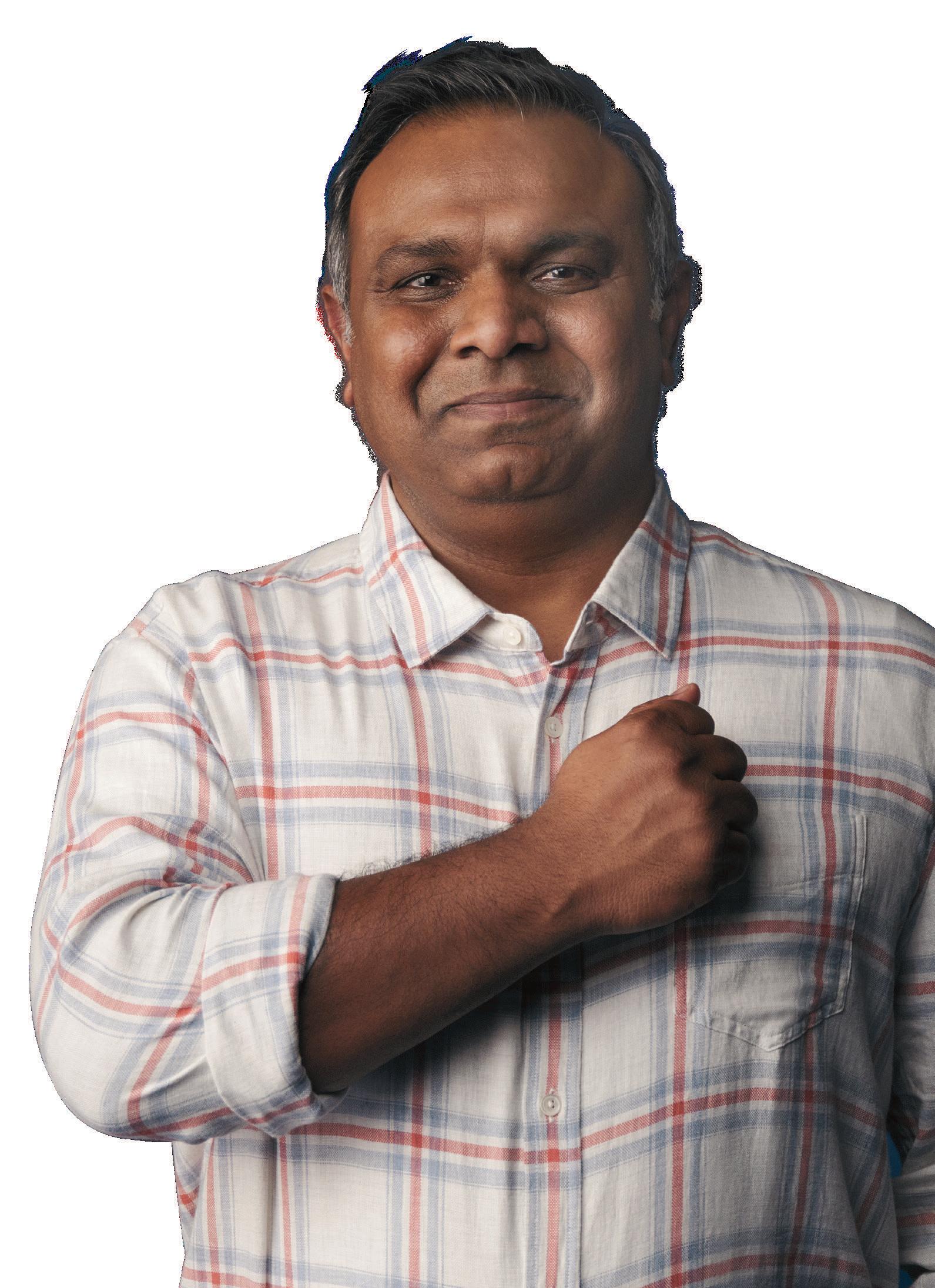
A WOMAN’S GUIDE TO BETTER HEALTH NEW WAYS TO FIGHT LUNG CANCER KIDNEY DONORS SAVE LIVES WEIGHT LOSS SURGERY: HEALTHIER FOR LIFE

HealingHearts WITH ADVANCED IMAGING



A WOMAN’S GUIDE TO BETTER HEALTH NEW WAYS TO FIGHT LUNG CANCER KIDNEY DONORS SAVE LIVES WEIGHT LOSS SURGERY: HEALTHIER FOR LIFE

HealingHearts WITH ADVANCED IMAGING


RWJBarnabas Health is proud to collaborate with like-minded organizations in pursuit of our noble mission to build and sustain healthier communities. We are pleased to announce that we are strengthening our long-standing partnership with the New Jersey Devils to expand our shared vision to support active and healthy lifestyles across our great state.
As a symbol of our shared commitment, the RWJBarnabas Health logo will be featured on all Devils home jerseys as we become the club’s first-ever patch partner.
Details of this remarkable partnership are in the pages that follow. While we will continue to provide world-class care to professional athletes, of equal importance are the community-based health initiatives that will be enhanced through our partnership with the Devils.
Together, we have developed hockey rinks through joint programs, 15 of which offer Learn to Play programs to introduce youth to hockey. More than 115 teams and organizations now play at the RWJBarnabas Health Hockey House in Newark, and RWJBarnabas Health’s combined blood drives with the Devils have resulted in 368 units of critical, lifesaving donations.
We look forward to our continued work with the Devils to benefit the residents of New Jersey and beyond. On behalf of my 41,000 terrific colleagues, I thank you for entrusting RWJBarnabas Health with the privilege of caring for you and your family.
Sincerely,
MARK E. MANIGAN PRESIDENT AND CHIEF EXECUTIVE OFFICERRWJBarnabas Health complies with applicable federal civil rights laws and does not discriminate on the basis of race, color, national origin, age, disability or sex. For more information, see the link on our home page at www.rwjbh.org.
RWJBarnabas Health provides free language services, including qualified interpreters, to people whose primary language is not English. The following Language Assistance Services information is provided in multiple languages.
ESPAÑOL
ATENCIÓN: Si habla español, tiene a su disposición servicios gratuitos de asistencia lingüística.
Llame al 1.844.465.9474
繁體中文
注意:如果您使用繁體中文,您可以免費 獲得語言援助服務。
致电1.844.465.9474
한국어
주의: 한국어를 사용하시는 경우, 언어 지원 서비스를 무료로 이용하실 수 있습니다. 1.844.465.9474 로 전화하십시오.
PORTUGUÊS
ATENÇÃO: Se fala português, encontram-se disponíveis serviços linguísticos, grátis. Ligue para 1.844.465.9474
ગુજરાતી
સુચના: જો તમે ગુજરાતી બોલતા હો, તો નિ:શુલ્ક ભાષા સહાય સેવાઓ
POLSKI
UWAGA: Jeżeli mówisz po polsku, możesz skorzystać z bezpłatnej pomocy językowej. Zadzwoń pod numer 1.844.465.9474
ITALIANO
ATTENZIONE: In caso la lingua parlata sia l’italiano, sono disponibili servizi di assistenza linguistica gratuiti. Chiamata 1.844.465.9474
@RWJBarnabasHealth
@RWJBarnabas
RWJBarnabas Health
RWJBarnabas_Health
linkedin.com/company/
RWJBarnabasHealth


It often begins with a 911 call from a family member. In many cases, a loved one who has been diagnosed with a serious mental illness has stopped taking medication and/or is exhibiting concerning behaviors. Often the person is acting erratically or has withdrawn from others and can’t be convinced to seek care or go to a hospital. The family member may be concerned about the loved one’s safety—or their own.
Such situations carry a heightened risk of escalating and requiring the use of force—or even triggering violence—when police respond with lights and sirens. But a new state-funded program through New Jersey’s Office of the Attorney General has helped people get the care they need in ways that are likelier to be effective, compassionate and safe.
The initiative is called ARRIVE Together, using an acronym for Alternative Responses to Reduce Instances of Violence and Escalation. It began as a co-response program with a plainclothes, Crisis Intervention Team-trained law enforcement officer responding to calls together with a certified New Jersey mental health screener such as those available through RWJBarnabas Health (RWJBH) Behavioral Health Services, with the two arriving in an unmarked car.
The certified screener assesses the crisis and determines whether the person requires hospitalization or a more thorough evaluation at a mental health screening center.
If the person in crisis needs further care, the certified screener engages the
person to go voluntarily or, if necessary, arranges for involuntary transport. When the person does not pose an imminent danger, the screener provides referrals to community-based support services that could help.
“It’s important to provide the right environment to speak with the patient and family,” says Frank Ghinassi, PhD, Senior Vice President of Behavioral Health Services at RWJBH and President and Chief Executive Officer of Rutgers University Behavioral Health Care. “We need to conduct a thorough assessment in a nonthreatening environment where the patient understands that we are there to support them and their health status, not to arrest them.”
ARRIVE Together has rolled out gradually across the state since its founding in December 2021. The initiative has expanded its scope by incorporating additional models tailored to address the specific needs of communities, taking into account their available resources. These models encompass a telehealth initiative, a follow-up protocol and a proactive engagement strategy, particularly implemented at various NJ Transit locations across the state.
Through ARRIVE Together partnerships and flexibility in tailoring solutions to community needs, the program successfully extended its reach to all 21
counties in New Jersey within a two-year time frame. ARRIVE Together is in place throughout the RWJBH system.
Middlesex County began the program in May 2023 through a partnership with Rutgers University Behavioral Health Care.
Pilot programs have shown that ARRIVE Together not only can reduce the need for use of force but also can increase the use of mental health services, decrease racial disparities across outcomes and shorten response times.
“The program has deepened the appreciation that providers and law enforcement have for each other’s roles and our mutual commitment to support people in our communities who struggle with mental health issues,” Ghinassi says. “It’s been very successful.”
“Through the synergy of law enforcement, mental health professionals like our partners at RWJBarnabas Health Behavioral Health Services and the community, ARRIVE Together stands as a testament to the boundless potential of collaboration to best serve the needs of our communities,” says Attorney General Matthew J. Platkin. “This first-of-its-kind statewide initiative demonstrates the transformative power of partnership, reshaping public safety while redefining the realm of achievable possibilities in providing essential mental health services to every corner of our state.”
To learn more about behavioral health services, visit www.rwjbh.org/behavioralhealth

Having grown up in the area, Genesis Jimenez knows how important and convenient it is that residents of East Brunswick and surrounding communities now have enhanced access to state-of-theart children’s health services at a new 52,000-square-foot facility.
The recent opening of the
RWJBarnabas Health Medical Group Pediatric Orthopedic and Specialty Services practice, in addition to a new Children’s Specialized Hospital (CSH) location, offers care for children facing special healthcare needs.
Among those children is Genesis’ daughter, Nyla Moreno. The toddler has two rare conditions that affect brain
function or development. One, called lissencephaly or “smooth brain,” occurs when folds and bumps don’t develop on the brain’s surface. The other, called Lennox-Gastaut syndrome, is a severe form of epilepsy that causes multiple types of seizures.
The new East Brunswick facility has become like a second home for the family, Genesis says. Three times a week, Nyla attends therapy at CSH, where Genesis says staff is attentive to her daughter and tuned in to cues that indicate an oncoming seizure.
Since starting therapy at CSH, Nyla has gained better head control, established better eye contact and tracking, started reaching and grabbing for toys, and worked on eating/feeding skills. Just as important, Genesis says, she and her fiancé have gained hope for Nyla’s future.
FOCUSED ON NEEDS
The new facility, located at 645 State Route 18, provides infants through adolescents with innovative, expert care related to bone and muscular conditions, chronic illnesses and complex physical disabilities as well as developmental, behavioral and mental health concerns.
The facility’s recent ribbon-cutting isn’t “just about opening a new door for pediatric specialty care; it’s about strengthening our roots in Middlesex County and Central New Jersey, bringing world-class expertise and innovative technology closer to home,” says Mark E. Manigan, President and CEO of RWJBarnabas Health (RWJBH). “We’re really proud of what we’re doing in children’s health. We have the most significant and extensive pediatric care network in the state of New Jersey. We continue to invest in it, and we will continue to grow it so that no one has to leave the state—and ideally no one has to leave their community—to get the
Genesis Jimenez and her daughter, Nyla Moreno (front), celebrate the opening of the new East Brunswick facility with (from left) Nyla’s grandmother Luana Vizcaino-Jimenez; Mark E. Manigan, President and CEO, RWJBarnabas Health; Matthew B. McDonald III, MD, President and CEO, Children’s Specialized Hospital; and Nyla’s grandmother Leila Moreno.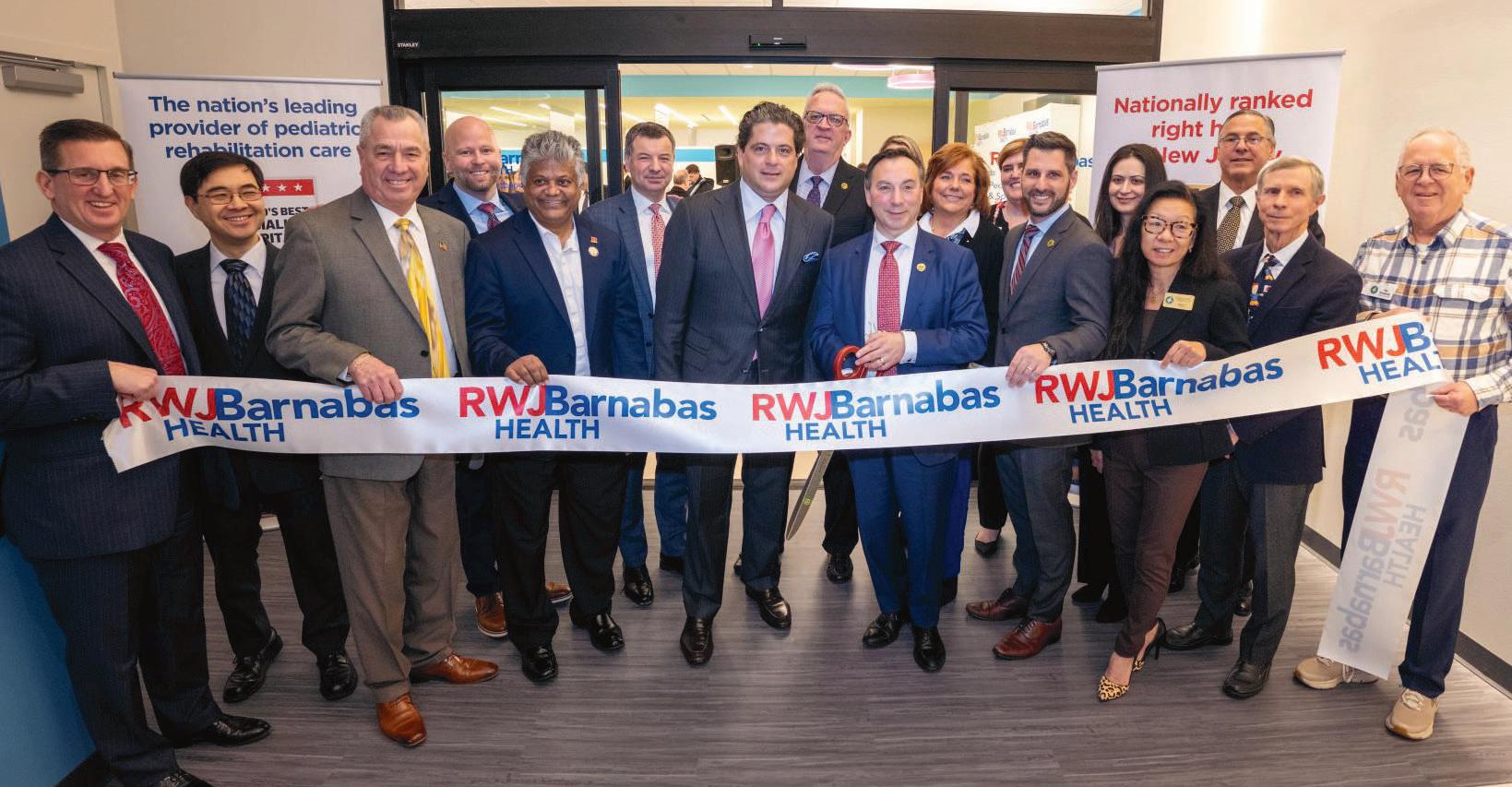
Pediatric orthopedic services at the RWJBarnabas Health facility in East Brunswick are equipped with a cutting-edge system for radiographic imaging that’s especially beneficial for children.
Called EOSedge, the technology consists of a precise, low-dose system that provides full-body, high-quality images covering a full gamut of musculoskeletal and orthopedic examinations. The system’s innovative design minimizes radiation exposure while giving providers insights they need to make well-informed clinical decisions at each point of patient care.
best care for their kids.”
The pediatric orthopedic center offers care for children with spinal deformities, inflammatory and infectious problems, fractures, sports-related injuries and many other orthopedic issues.
CSH offers a wide range of medical and therapeutic rehabilitative services including physical therapy, occupational therapy, speech-language therapy, developmental behavioral pediatrics, physiatry and more.
“There are nearly 250,000 children living with a unique healthcare challenge across New Jersey. This facility will offer them a comprehensive range of services focused on their individual needs and will provide children and families in the region a supportive environment to receive expert, family-centered care,” says Matthew B. McDonald III, MD, President and CEO of CSH. “Sharing this space with our system partners not only allows us to enhance the availability of our specialized services for those who need them but also provides local families with access to a variety of medical services in one convenient location.”
The facility is strategically positioned along with other RWJBH locations in nearby communities to serve patients and families in Central Jersey. Both the new East Brunswick facility and the
Anne Vogel Family Care and Wellness Center in Eatontown concentrate a wide range of services for women, children and families, including other pediatric specialties and CSH outpatient services.
Further demonstrating a commitment to high-quality healthcare, RWJBH children’s hospitals recently were named among the nation’s Best Children’s Hospitals for 2023-2024 by U.S. News & World Report , a global leader in quality rankings.
Additional pediatric services in partnership with Rutgers Robert Wood Johnson Medical School will be added to the facility, including endocrinology, genetics, pulmonology and neurology.
Women will also soon have access to comprehensive breast health services with the opening of the RWJBarnabas Health/Rutgers Cancer Institute
Breast Center and New Jersey Imaging Network. This addition continues RWJBH’s commitment to bringing the most advanced cancer care from New Jersey’s only NCI-Designated Comprehensive Cancer Center close to home. JAG Physical Therapy will also provide services at the new East Brunswick practice in the near future.
Benefits for young patients include enhanced safety, faster diagnosis through clear and accurate images and improved comfort with a spacious cabin design that fosters a stress-free environment during imaging sessions.
Reducing radiation exposure is especially desirable in the growing bodies of children, says J. Andrew Bowe, MD, pediatric orthopedic surgeon with RWJBarnabas Health Medical Group and Medical Director, Pediatric Orthopedic Surgery, at The Bristol-Myers Squibb Children’s Hospital at Robert Wood Johnson University Hospital. Compared with conventional X-rays, the EOSedge system reduces the amount of radiation by about 80 percent, he says.
“It also makes images clearer and diagnosis a bit easier,” Dr. Bowe adds.
“It’s a wonderful machine, and I’m excited to have it in our new facility.
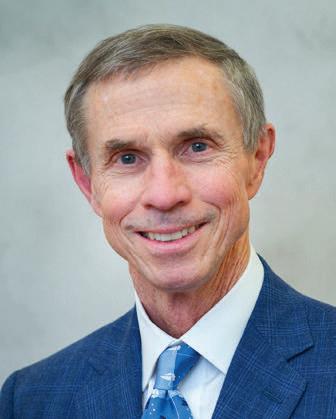
J. ANDREW BOWE, MD
To learn more about children’s care at RWJBarnabas Health, visit www.rwjbh.org/childrenshealth
We’re thrilled to welcome new and familiar families at East Brunswick and to continue providing the highest-quality orthopedic care in the neighborhood.”
Leadership of RWJBarnabas Health, Children’s Specialized Hospital and The Bristol-Myers Squibb Children’s Hospital at Robert Wood Johnson University Hospital gather at the East Brunswick facility’s ribbon-cutting ceremony.Surgery helped Stephanie Savanchuk (far right) protect her kidneys, supported by (from left) her father, Petro; brother, Ivan; and mother, Halyna.
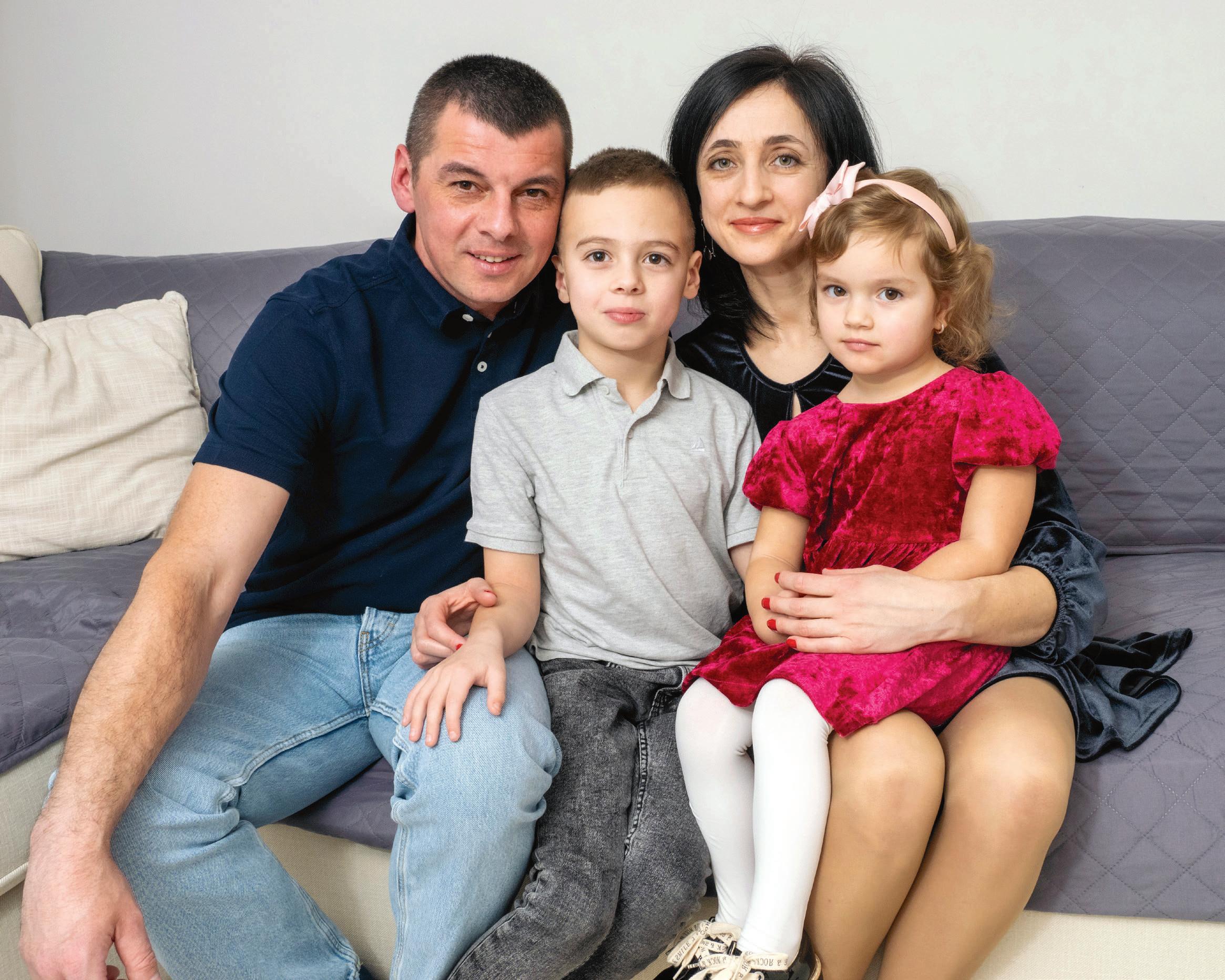
WHEN A CHILD DEVELOPED A SERIOUS UROLOGICAL CONDITION, PEDIATRIC SPECIALISTS TEAMED UP TO FIND THE BEST TREATMENT.
Learning that your child has a serious medical condition is a parent’s worst nightmare. But for Petro and Halyna Savanchuk of Scotch Plains, the news was tempered with hope.
When a pregnancy ultrasound suggested that their daughter, Stephanie, had a dilated urinary tract system, a common urological problem that could be secondary to various conditions,
they learned she had a good chance of outgrowing the issue with little intervention. If that turned out not to be the case, expert pediatric nephrology and urology teams at RWJBarnabas Health (RWJBH) Children’s Health network would be able to help.
After her birth, Stephanie had an abnormal backflow of urine from the bladder up one or both of the ureters— the tubes that connect the kidneys to the bladder. (Normally, urine flows from the kidneys to the bladder before exiting the body.) The condition is most common in infants and young children.
“With this condition, the valve mechanism that prevents urine from shooting back toward the kidneys is faulty,” says pediatric urologist Haris S. Ahmed, MD, Co-Chief of the Robotic Surgery Program at The Bristol-Myers Squibb Children’s Hospital (BMSCH) at Robert Wood Johnson University Hospital in New Brunswick. “That can allow urine to back up to the kidneys, which can damage them.”
Although most affected children grow out of the problem, it became clear over time that Stephanie wasn’t going to be among the fortunate majority.
Doctors had first known something was wrong because Stephanie’s left kidney showed signs of hydronephrosis, a condition that occurs when one or both kidneys become stretched and dilated because urine has built up inside them.
When Stephanie was 2 months old, the Savanchuks met with pediatric nephrologist M. Isabel Roberti, MD, PhD, Director of the Children’s Kidney Center at Cooperman Barnabas Medical Center (CBMC), to discuss the problem. A procedure called a cystogram confirmed the reflux diagnosis.
Stephanie’s case was grade 5, which indicates greater severity. “You follow patients at this level closely,” Dr. Roberti says. “If the dilatation remains, patients often need surgery.”
Another factor to weigh was Stephanie’s kidney function. “The right kidney worked 71 percent,” remembers Petro. “But the left kidney was only 29 percent. At the time, it was not a big problem because both kidneys were adequately clearing waste products. But we didn’t know what the future would hold.”
A multidisciplinary team of RWJBH providers considered the complex variety of factors and consulted with one
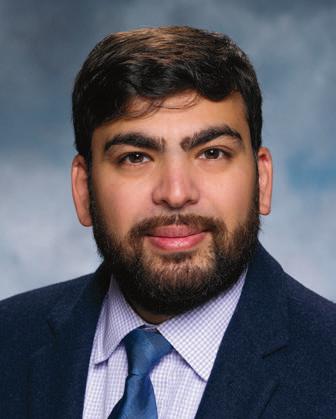

another to determine the best course of action as Stephanie’s condition evolved.
“The collaboration is immediate,” says Dr. Roberti. “If I have a serious case, I can text Dr. Ahmed and he replies right away. We work very closely together.”
RWJBH providers have access to a large and varied network of specialists who are able to bring their capabilities to bear on a given patient’s care. The system’s children’s hospitals were named among the nation’s Best Children’s Hospitals for 2023-2024 by U.S. News & World Report, with BMSCH ranking 47th for urology. The urology ranking recognizes a four-hospital practice that is based at BMSCH but also provides care at three other RWJBH hospitals: Children’s Hospital of New Jersey at Newark Beth Israel Medical Center, McMullen Children’s Center at CBMC and Unterberg Children’s Hospital at Monmouth Medical Center. Similarly, pediatric nephrology care is offered systemwide.
“That breadth and depth of expertise is something we offer that not many places do,” says Dr. Ahmed.
“It’s important to receive care in a center where doctors work together in order to prevent any complications and in general facilitate the care of the child,” Dr. Roberti adds.
After Stephanie turned 18 months, her situation came into sharper focus. “She’d had recurrent febrile urinary tract infections [UTIs], which are severe UTIs that have been shown to cause scarring of the kidneys,” says Dr. Ahmed. “When a patient is on a suppressive antibiotic to prevent UTIs, it means a UTI that occurs is all the more severe because it managed to break through the antibiotic.”
Dr. Roberti and Dr. Ahmed began to talk seriously about surgery to reposition Stephanie’s ureter in a way that would prevent urine from backing up during
urination and entering the kidney. “We didn’t want to risk further kidney damage,” Dr. Ahmed says.
As with specialized pediatric urology and nephrology care, pediatric surgery is available throughout the RWJBH system, giving Stephanie access to a robotic procedure performed by some of the most experienced pediatric surgeons in New Jersey. The RWJBH pediatric robotic surgery program is the first of its kind in the state to be accredited.
Robotic surgery is performed through small incisions using instruments that the surgeon controls from a console. The system can maneuver into hard-to-reach places and greatly magnifies the surgeon’s field of vision. Patients usually spend no more than a night in the hospital, and recovery time is short.
“It’s not very common to do this procedure in young kids,” says Dr. Ahmed. “The smaller a child is, the more challenging it is to do robotic surgery because the space inside the abdomen is limited. But this is something we specialize in.”
The alternative would be to make a larger abdominal incision and cut through muscles. Patients getting this traditional type of surgery usually have a three- or four-day hospital stay and a longer, more painful recovery.
On the day of surgery, Petro and Halyna were nervous and worried. While the procedure itself took about two hours, “We didn’t see our daughter for a few hours,” Petro says. “It was so hard to wait. I’ll never forget that day.”
But Stephanie did well—and has thrived since.
“Her condition is now in the rearview mirror,” says Dr. Ahmed. “Her reflux was cured, and she has not had any additional UTIs.”
“I’m thankful for the doctors and nurses who helped my daughter,” says Petro. “Her health problem was very stressful for us, but that’s all gone now— because she’s OK.”
UNDERGOING A BARIATRIC PROCEDURE HELPS A WOMAN FINALLY ACHIEVE HER WEIGHT LOSS GOALS.
 Damaris Garcia exercises regularly to build muscle after losing more than 50 pounds with the help of weight loss surgery.
Damaris Garcia exercises regularly to build muscle after losing more than 50 pounds with the help of weight loss surgery.

Damaris Garcia, a 48-yearold single mom who lives in Lawrenceville with her 26-year-old daughter, had struggled with her weight for more than two decades. Taking medications to treat endometriosis that developed after the birth of her daughter “created a roller coaster with my weight,” says Damaris, who recently left a longtime career with the Educational Testing Service. “I would gain weight, lose it and then gain it all back, plus more.”
Throughout her 30s and early 40s, Damaris tried many methods and spent thousands of dollars to get control of her weight, including through popular weight loss programs, a private trainer and medically supervised injections and shakes. “Nothing worked for long,” she says.
After she underwent a hysterectomy in 2017, weight loss became even more difficult. “I was hitting the gym six or seven times a week, had eliminated processed foods and was really watching what I was eating,” she says. “Still no success.”
By 2022, she was the heaviest she had ever been, at 5 feet, 1 inch and 184 pounds. When one of her best friends got married at a beach resort, Damaris was excited to be in the wedding party—until she saw the photographs. “I saw myself and cried,” she says. “I literally looked like I was pregnant. I said, ‘That can’t be me!’ That’s when I really started doing my research about weight loss surgery options.”

program is among the best in the nation, with a team of board-certified, fellowship-trained surgeons who perform hundreds of bariatric, or weight loss, surgeries annually with low complication rates.
“We all use the same cutting-edge surgical techniques, with minimal to no variation in how our surgeries are done, leading to more consistency, less variability and better outcomes,” says Lora Melman, MD, who met with Damaris to discuss her options in January 2023.
Preoperative testing revealed that Damaris’ obesity had contributed to multiple health problems, including asthma, sleep apnea and hyperlipidemia—an abnormally high level of lipids such as cholesterol and triglycerides in the blood, which has been linked to heart attack and stroke.
In a multidisciplinary approach, the program’s surgeons work closely with subspecialists including cardiologists, endocrinologists, pulmonologists, nutritionists and behavioral health professionals to holistically improve patient health.
Several types of bariatric surgery are available to match a patient’s needs and preferences. Dr. Melman recommended that Damaris undergo gastric sleeve surgery, a minimally invasive procedure in which much of the stomach is removed. The remaining stomach forms a narrow tube called a sleeve, which holds much less food and liquid than before surgery, so a person feels full after eating relatively little.
She found what she was looking for with the Weight Loss and Bariatric Surgery program at RWJBarnabas Health (RWJBH). Led by Ragui Sadek, MD, Chief of Bariatric Surgery at RWJBH, the
During a monthslong period of preparation, Damaris met with psychologists and nutritionists to establish a healthy eating plan that she could sustain for the long term. “It was not just a matter of reducing my stomach, but preparing for a different lifestyle,” she says.
By the time her bariatric surgery was
performed at Robert Wood Johnson University Hospital Hamilton in September 2023, Damaris weighed in the mid-160s. The procedure took about 45 minutes under general anesthesia. She spent one night in the hospital and was able to go home the next day.
“We have developed a fast-track surgery protocol called enhanced recovery after surgery [ERAS] to reduce the physiologic stress of the procedure,” Dr. Melman says.
Part of the ERAS process is “prehabilitation,” in which patients work to improve their nutritional and fitness status. During surgery itself, nursing, anesthesia and surgical teams collaborate to minimize the time a patient spends under general anesthesia and reduce the use of narcotic pain medications. Teams also get patients up and walking right away. “We use nerve blocks in the abdominal wall to minimize pain,” Dr. Melman says.
For the first full week after surgery, Damaris consumed only clear liquids. Under Dr. Melman’s supervision, she gradually moved on to other liquids, then purees, then soft foods.
At her three-month postsurgical visit in January 2024, Damaris weighed 132 pounds. “They now don’t want me to continue losing weight, but instead to focus on rebuilding muscle, so I’ve been hitting the gym a lot,” she says.
These days, Damaris sometimes does a double take when she looks in the mirror. “I haven’t seen myself this thin and healthy in 27 years, and I’ve had to get all new clothes,” she says. “My friends are surprised when they see me, too. I’ve gotten so many compliments!”
But her focus remains on staying healthy for the rest of her life. “I had told myself that when I hit 50, I didn’t want to be dealing with all the medical effects that I could foresee happening because of my weight,” she says. “And now I feel great! I sleep so much better at night, and I wake up with tons of energy.”


HOW A NEW ROBOTICASSISTED SURGERY HELPS REDUCE PAIN, SPEED HEALING AND IMPROVE OUTCOMES
When you take a road trip, you trust your car’s global positioning system (GPS) to help you find the best route to your destination. Now, when specialists at Robert Wood Johnson University Hospital (RWJUH) Hamilton perform complex spine procedures, they use a leading-edge navigation system to create the best surgical outcomes possible.
While Globus Medical’s ExcelsiusGPS
technology isn’t a GPS in the classic sense, it is one of the first surgical systems to combine a robotic arm with full computer-assisted navigation capabilities. As a result, surgeons can perform robotic-assisted spine surgery with enhanced precision.
Here’s how it works. Prior to the start of a minimally invasive spine procedure, surgeons upload a patient’s X-ray and CT scans into the ExcelsiusGPS robot.
“The surgeon, with assistance from the software, then selects the best trajectory and position for the procedure based on those images and the patient’s anatomy,” says Jose Canseco, MD, PhD, a fellowship-trained orthopedic spine surgeon with Rothman Orthopaedic Institute who is pioneering the use of ExcelsiusGPS at RWJUH Hamilton.
During the procedure, a surgeon uses the predetermined surgical plan to guide the system’s robotic arm into the exact position. The surgeon then inserts screws through the arm and places them into the appropriate locations. “The surgeon is still in full control and performs the procedure,” Dr. Canseco says. “But the robot helps us increase the accuracy of screw placement and create better results.”
Patients benefit in multiple ways, including faster recovery times and less pain.
“RWJUH Hamilton has long been a leader in providing exceptional care for patients with spinal conditions,” says Lisa Breza, RN, Chief Administrative Officer, RWJUH Hamilton. “With the introduction of robotic spine surgery, we are further solidifying our commitment to offering the latest, most advanced technology to our patients.”
ExcelsiusGPS can be used for nearly any procedure involving the cervical, thoracic, lumbar or sacral spine. Dr. Canseco sees added benefits for people who need minimally invasive spine surgery, corrective surgery to fix spinal curvature disorders such as scoliosis, or revision spine surgery.
“With the robot, we can keep the size of the incision very small, which leads to less tissue disruption and minimal scarring,” Dr. Canseco says. “And the robot’s added precision allows us to achieve better alignment for complex scoliotic procedures.”

Dr. Canseco gained experience with the ExcelsiusGPS system during his fellowship training
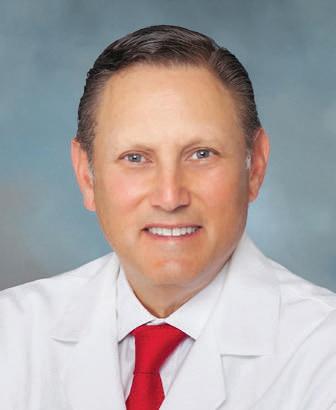
For golfers this spring, sand traps aren’t the only hazards to avoid.
“Low back pain is common, especially in golfers over 50,” says Marc J. Levine, MD, Chief of Orthopedic Surgery and Director of Spine Surgery at Robert Wood Johnson University (RWJUH) Hamilton, a member of RWJBarnabas Health Medical Group and a clinical assistant professor at Rutgers New Jersey Medical School.
Most low-back injuries in golfers, Dr. Levine says, stem from stress on the spine associated with swinging a golf club. “Often, pain remains localized to the lower back, but occasionally it can become sciatic and radiate down one or both legs,” he says.
He offers these tips for warding off back injuries on the links:
• Don’t emulate the pros. Many professional golfers today use the “modern golf swing,” keeping their hips stationary, twisting their upper body and following through forcefully. While it may make a golf ball travel farther, “The thoracic and lumbar spine can’t absorb that kind of force regularly, especially if you’re over age 50,” Dr. Levine says. A safer approach is to use a swing that’s comfortable for you and to have realistic expectations about how far you can drive a golf ball.
• Keep your swing consistent. “Your body likes predictability,” Dr. Levine says. “Every time you jerk or move unexpectedly, it creates more strain on your back.” Dr. Levine recommends meeting with a golf pro at least once a year to evaluate your swing. Ask for tips to improve your mechanics and ergonomics.
• Stay physically fit. A regular exercise routine can strengthen core muscles, including those in your abdomen and back. “Also, do stretching exercises for at least five to 10 minutes before you start each round of golf,” Dr. Levine says.
• Use the right equipment. “Choose shoes that will help you stabilize your feet, so you don’t lose traction,” Dr. Levine says. If you’re thinking about new clubs, look for ones with less rigidity in the shaft. “That will absorb some of the energy when you take a backswing and may create less force on your spine,” Dr. Levine says.
If you feel a twinge of back pain after a round of golf, Dr. Levine recommends rest, ice and over-the-counter anti-inflammatory medicines (aspirin, ibuprofen) as a first line of treatment. See a doctor if pain continues for four to six weeks. “If you experience any numbness, tingling or weakness, get evaluated by an orthopedic surgeon,” Dr. Levine says.

and is a certified expert in using the technology.
Robotic-assisted surgery, says Dr. Canseco, adds to the advanced capabilities at RWJUH Hamilton, which is one of just a few hospitals in New Jersey nationally certified in spine surgery by The Joint Commission.
“The investment in state-of-theart technology shows that RWJUH Hamilton is committed to maintaining excellence in spine surgery,” Dr. Canseco says. “It also means that people in the Capital Region can find the highestquality care for even the most complex spine procedures right in their backyard.”
To learn more about spine care at RWJBarnabas Health, visit www.rwjbh.org/spine

A WOMAN’S GUIDE TO KEY SCREENINGS AND OTHER STEPS THAT CAN IMPROVE WELLBEING THROUGHOUT LIFE
Women’s health concerns often focus on milestones such as pregnancy, childbirth and menopause. But day-to-day and year-toyear health maintenance and preventive measures are also critical to well-being throughout life.
“Getting recommended exams, screenings and immunizations are some of the most important things you can do to prevent problems or catch them earlier, and stay healthier longer,” says Suzanne Spernal, DNP, APN-BC, RNCOB, C-ONQS, Senior Vice President of Women’s Services at RWJBarnabas Health. “Maintaining a healthy weight throughout the life span is also key to living healthy.”
Here are vital steps to take—and details on when to take them— throughout a woman’s adult life.
in EACH DECADE
Working with your healthcare provider to keep on top of regular tests and practices throughout life can have long-term benefits by detecting or monitoring chronic conditions that, left unchecked, often snowball into potentially serious problems.
• Full checkup: See a primary care provider yearly.
• Sleep habits: Discuss at your annual exam.
• Thyroid (TSH) test: Discuss with your healthcare provider.
• HIV screening: Get tested if you are at risk for HIV infection (due to, for example, unprotected sex, sexually transmitted disease or use of drugs with needles).
• Blood pressure test: Get one at least every two years if not at your annual checkup.
• Cholesterol panel: Establish your total, LDL, HDL and triglycerides in your 20s. Discuss follow-up with your provider in subsequent years.
• Blood glucose or A1C test: Get screened if you have sustained blood pressure greater than 135/80, take medicine for high blood pressure or are at risk of developing diabetes.
• Skin exam: Do a self-exam of skin and moles monthly and as part of a routine full checkup.
• Dental cleaning and exam: See your dentist twice yearly.
• Behavioral health screening: Talk with your provider about whether this would be helpful.

in your 20s and 30s Early adulthood is the time to establish a baseline of regular self-checks, exams and screenings that you can build on in the decades to come. You’ll continue many of these practices as you age.
• Breast self-exam: Regularly examine your breasts and become familiar with them so you can identify any changes and discuss them with your provider.
• Clinical breast exam: Have a provider check your breasts at least every three years.
• Pap test: Undergo screening for cervical cancer at least every three years.
• Pelvic exam: See your obstetriciangynecologist yearly beginning at age 21.
• Sexually transmitted infection (STI) tests: Both partners should get tested for STIs, including HIV, before initiating sexual intercourse. Get a
chlamydia test yearly until age 24 if you are sexually active. After age 25, continue getting this test yearly if you have new or multiple partners.
• Seasonal influenza vaccine: Get your shot yearly.
• COVID-19: Keep up to date with boosters.
• Tetanus-diphtheria-pertussis booster vaccine: Update every 10 years.
• Human papillomavirus (HPV) vaccine: Protect against HPV with a single twodose series up to age 26; if your vaccine series is incomplete, talk with your provider.
• Meningococcal vaccine: Discuss with your provider if you are in college or in the military.
in your 40s and 50s
Continue following recommendations from your 20s and 30s for breast and reproductive health or discuss with your doctor, and keep up with recommended immunizations. Add the following.
• Bone density screening: Talk with your provider about guarding against bone conditions such as osteoporosis.
• Mammogram: Get yearly screening mammograms beginning at age 40.
• Comprehensive eye exam: If you haven’t already done so, see an eye doctor for a baseline exam at age 40, then every two to four years as your doctor advises. At age 55, start getting eye exams every one to two years.
• Hearing test: Have your hearing tested in your 40s. Retest after 10 years, then every three years from your 50s on.
• Fecal occult blood test, flexible sigmoidoscopy, colonoscopy: Starting at age 45, get screened for colorectal cancer. Talk with your provider about
which screening test is best for you and how often you need it.
• Hepatitis C (HCV) screening: Get this onetime screening in your 50s if you were born between 1945 and 1965.
in your 60s, 70s and BEYOND
Continue following recommendations from your 40s and 50s for breast, reproductive, colorectal and eye/ear health, and keep receiving scheduled immunizations. Address the following considerations.
• Hepatitis C (HCV) screening: If you haven’t already been screened for hepatitis C and were born between 1945 and 1965, get your test.
• Mammogram: Continue screening annually through age 74; discuss with your provider from age 75 on.
• Pap test: Discuss continued testing with your provider.
• Bone density screening: If you haven’t yet had a bone mineral test, get it at least once, ideally by around age 65. Talk with your provider about repeat testing.
• Pneumococcal vaccine: Get this onetime vaccine to protect against pneumococcal disease.
• Herpes zoster vaccine: Talk with your provider about preventing shingles and painful complications with a onetime, two-shot series.

Many patients schedule regular mammograms and colonoscopies to screen for cancer, but don’t think of taking the same approach for the heart. That perspective is changing due to ever more sophisticated screening technologies at RWJBarnabas Health (RWJBH), New Jersey’s largest network of noninvasive, advanced cardiovascular imaging centers.
Cardiovascular screenings can catch heart and vascular conditions in early stages. Left untreated, many conditions progressively worsen. With certain conditions, proactive imaging offers opportunities to not only diagnose but also treat conditions—including
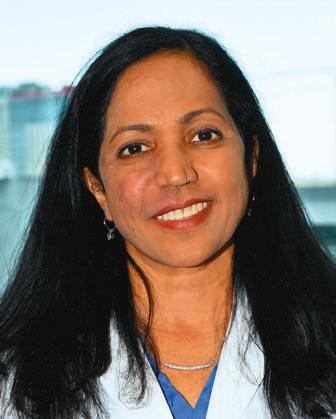
Whoever your heart beats for, our hearts beat for you. To connect with a top cardiovascular specialist at RWJBarnabas Health, call 888.724.7123 or visit www.rwjbh.org/heart.
endorsed by the American College of Cardiology and the American Heart Association.
KAMESWARI MAGANTI, MD, FACC, FASEhypertensive heart disease, coronary artery disease, aortic valve stenosis, mitral valve regurgitation, aortic aneurysm or increased risk of heart disease due to prior cancer treatments— before they become life-threatening problems such as a heart attack or heart failure. Appropriate cardiac imaging techniques are many; the exact diagnostic testing is determined by the treating physician and
At RWJBH, physicians use advanced imaging technologies combined with integrated medical records and artificial intelligence to identify, monitor and track cardiac performance. These methodologies increasingly help cardiologists predict the need for specific therapies such as medical therapies or interventions; ultimately help patients understand their disease and the possibility of progression; and aid in individualized, patient-centric treatment plans.
“Surveillance of valve diseases at
specific stages, for example, allows us to monitor the progression of the disease and its impact on heart function, and allows precise timing of valve intervention so that patients receive the appropriate treatment at the most propitious moment for the best benefit,” says Kameswari Maganti, MD, FACC, FASE, a cardiologist with RWJBH at Robert Wood Johnson University Hospital in New Brunswick. “RWJBH has enormous resources in both advanced technologies and expertise that—combined with pioneering work in artificial intelligence—will have a huge and growing impact on earlier identification of abnormalities, which will translate to excellent patient care.”
Imaging technologies can save lives, as indicated by patients who have already benefited from these amazing diagnostic tools.
How it helps: Measuring electrical activity in the heart can find abnormalities that may indicate conditions such as irregular heartbeat, clogged arteries, heart damage, heart failure or a heart attack.
Great catch: RJ. A then-16-yearold high school football player, RJ discovered through an EKG (administered by an RWJBH screening program for young athletes) that he had an abnormal extra electrical pathway in his heart that could trigger a rapid heart rate. RWJBH electrophysiologists corrected RJ’s condition with a minimally invasive procedure called catheter ablation—and he played his first varsity game just two weeks later.
How it helps:
Ultrasound imaging that measures the heart’s size, shape, strength and function can identify problems such as faulty valves, structural abnormalities, heart attack damage and heart failure.
Great catch: Virginia. She seemed at low risk of heart disease, but Virginia Haines noticed that she often became short of breath during activities such as climbing stairs. A stress echocardiogram—administered while exercising on a treadmill—found she had an obstructed coronary artery. A procedure called an angioplasty opened the blockage and staved off a heart attack.
How it helps: TEE is a type of ultrasound that takes pictures from a position inside a person’s esophagus, close to the heart. Its highly detailed images can help reveal problems such as faulty heart valves.
Great catch: Alex. When his primary care physician heard a heart murmur, Alex Martin went for heart testing. Alex was fit, but a TEE discovered that his heart’s mitral valve was abnormally allowing blood to flow backward. A procedure called mitral valve repair restored Alex’s heart function and installed a durable valve capable of lasting the rest of his life.
How it helps: Artificial intelligence helps create a 3-D model of a patient’s cardiac arteries, providing information that helps cardiologists assess blood flow and the significance of any blockages.
Great catch: Ray. As Director of Information Technology and Services at Monmouth Medical Center (MMC) and MMC Southern Campus (MMCSC), Ray Duarte underwent FFR-CT screening during testing of the technology for its pioneering use at MMCSC. The scan unexpectedly discovered that one of his coronary arteries was 99 percent blocked. Undergoing a procedure to open the
artery brought Ray back from the brink of a heart attack.
How it helps: This type of computerized tomography (CT) scan helps cardiologists learn about the presence, location and extent of calcified plaque in coronary arteries that can lead to a heart attack.
Great catch: Tony. Chest discomfort and pain in his left arm prompted Tony to seek help. When preliminary tests were inconclusive, RWJBH cardiologists ordered a calcium score, the most accurate way to detect potentially dangerous plaque buildups. Tony’s high score indicated he was at high risk of a heart attack—which a proactive bypass surgery helped him avoid.
How it helps: Combining technologies such as stress echocardiograms, CT scans and cardiac magnetic resonance imaging (MRI) lets cardiologists track heart valve anatomy, function and physiology. This helps them monitor abnormalities such as buildups of amyloid proteins that can lead to aortic stenosis and heart failure.
Great catch: Helen. A heart murmur provided the first indication that avid walker Helen Blumenthal had a thick, stiff aortic valve, characteristic of aortic stenosis. Annual echocardiograms helped monitor her condition. When a combination of monitoring and symptoms indicated that the time was ripe for a fix, she underwent a minimally invasive procedure called transaortic valve replacement—and was walking again six hours after surgery.



RWJBarnabas Health, in partnership with Rutgers Cancer Institute of New Jersey—the state’s only NCI-Designated Comprehensive Cancer Center—provides close-to-home access to the most advanced treatment options. Call 844.CANCERNJ or visit www.rwjbh.org/beatcancer.
EARLY DETECTION, ADVANCED TECHNOLOGY AND A TEAM APPROACH OFFER IMPROVED OUTCOMES.
Lung cancer is the leading cause of cancer deaths in the United States. The good news: State-ofthe-art early detection, new treatments and sophisticated new technologies— most of which are available across the state at RWJBarnabas Health (RWJBH) and Rutgers Cancer Institute of New Jersey, the state’s only National Cancer Institute-Designated Comprehensive Cancer Center—offer hope for
improving outcomes.
This is the message that Richard Lazzaro, MD, Chief of Thoracic Surgery for the RWJBH Southern Region, wants to spread far and wide. Dr. Lazzaro and his team treat all cancers and diseases of the thorax (chest) area. “Unfortunately, we continue to see many cases related to lung cancer,” he says.
Lung cancer is found early, when it’s most treatable, in just one in four
cancer patients, Dr. Lazzaro explains. “Our thoracic oncology group has a shared goal: to identify more patients with lung cancer at an earlier stage,” he says.
Just as screening can successfully detect breast and colon cancers at early stages, so too can a low-dose computed tomography (LDCT) screening find lung cancer when it is most treatable.
Smokers and former smokers between ages 50 and 80 who meet certain criteria are eligible for the LDCT test. Patients should consult with their primary care physician or find more information at www. USPreventiveServicesTaskForce.org.
“In New Jersey, the vast majority of patients who are eligible for a lung cancer screening don’t get it,” says Dr. Lazzaro. “Patients may not know about the test or may be offered it but not take it because of fear of what they might find out. However, people need to know that we can find lung cancer before a patient has any symptoms. And if we catch it at stage 1, we have a 90 percent cure rate.”
Lung cancer testing most often begins when a patient has troubling symptoms and is referred to a specialist who makes the diagnosis.
At RWJBH, the thoracic oncology team and a broad range of specialists participate in weekly multidisciplinary “tumor boards.” In these meetings, all relevant specialties— such as neurology, interventional pulmonology, interventional radiology, gastroenterology and more—discuss each patient’s case.
Specialists who attend tumor boards come from throughout the RWJBH system as well as from Rutgers Cancer Institute of New Jersey.

“Our goal is to get the patient to the right team for treatment as soon as possible,” says Dr. Lazzaro. “Ultimately, the group comes to
RWJBarnabas Health (RWJBH) offers two highly advanced technologies for the diagnosis and treatment of lung cancer, available at Monmouth Medical Center (MMC).
MMC is one of just two hospitals in New Jersey to have the Ion robot-assisted platform for bronchoscopy, a procedure that lets doctors visualize the inside of a patient’s lungs and airways.
“This is a phenomenal technology,” says Richard Lazzaro, MD, Chief of Thoracic Surgery for the RWJBH Southern Region and a national leader in the field of robotic thoracic surgery. “With Ion, we’re able to take a patient’s CT scan and make a 3-D holographic map. We see the patient’s lungs, trachea, bronchial tubes and any nodules that exist, including those on the surface of the lungs, which a traditional bronchoscopy did not allow us to see.”
MMC is the first hospital in New Jersey to offer the Aliya PEF system, which is used in conjunction with the Ion robot.
The system delivers high-voltage, high-frequency electrical currents that destroy abnormal cells while preserving surrounding healthy tissue. When Aliya PEF is combined with the Ion technology, diagnosis and treatment can occur in the same procedure.
a consensus on the best sequence of treatments for each individual patient.”
Historically, this type of decisionmaking can be a lengthy undertaking as a patient goes from specialist to specialist. “With our multidisciplinary approach, we expedite the process,” Dr. Lazzaro explains. “There are a lot of moving parts, but the approach is sophisticated, well organized, evidencebased and objective.”
Just a few decades ago, treatment for lung cancer was limited to surgery, radiation and certain kinds of chemotherapy.
“Now, since the sequencing of the human genome, there’s a lot more research into identifying mutations in cancers and developing drugs to target those mutations,” Dr. Lazzaro says. “We try to understand what’s going on in the DNA or chromosomes of an individual’s cancer. Is there anything in the
molecular pathology report that tells us if a cancer would benefit from a specific, targeted treatment such as immune therapy, which allows the patient’s immune cells to fight cancer cells?”
Modern cancer treatment often involves a variety of modalities. For example, treatment might begin with minimally invasive robotic surgery, from which the patient can recover relatively quickly and begin a course of chemotherapy or immunotherapy.
Advanced new technologies such as the Ion robot-assisted platform for biopsies and the Aliya PEF system for ablating lung lesions are opening even wider horizons for lung cancer treatment.
“The reality is that lung cancer is common—but lung cancer is beatable,” Dr. Lazzaro says. “We have a team to identify and treat it with the best that medicine has to offer. So don’t be scared. Get your screening; see your doctor. We can help.”
RICHARD LAZZARO, MD
RWJBARNABAS HEALTH AND THE NEW JERSEY DEVILS FORTIFY A LONG-STANDING RELATIONSHIP TO IMPROVE COMMUNITY HEALTH.
Continuing a nearly 30-year association, RWJBarnabas Health (RWJBH) and the New Jersey Devils have jointly announced the multiyear extension of their innovative partnership. The organizations have outlined a multitiered activation plan allowing the two brands to utilize shared resources and strengthen their impact in a shared vision of building healthier communities.
As part of the agreement, the Devils and RWJBH have developed a comprehensive, overarching youth hockey program to engage with children across New Jersey. Touching more than 40 hockey rinks throughout the state as part of the New Jersey Devils Rink
Partners program, this multiplatform initiative is designed to grow the sport of hockey via accessibility, training, on/off-ice skills and the promotion of health and wellness.
The Devils and RWJBH share a commitment to support children from the first day they step onto the ice through their high school years and beyond.
RWJBH has created an educational blueprint that will teach children and their families the importance of leading active, nutritious lifestyles and important injury prevention techniques, all with the goal of encouraging healthy habits at a young age. This is combined with the Devils’ support of coaching,
mental health and athlete care seminars, providing participants with access to NHL-level guidance and education.
“The opportunity to strengthen RWJBarnabas Health’s 30-year partnership with the New Jersey Devils reinforces our shared commitment to improve community health,” says Mark E. Manigan, President and Chief Executive Officer, RWJBH.
Serving as a visual representation of the enhanced collaboration and commitment, RWJBH becomes the team’s first-ever home jersey patch partner, a strategic move designed to strengthen the brand association
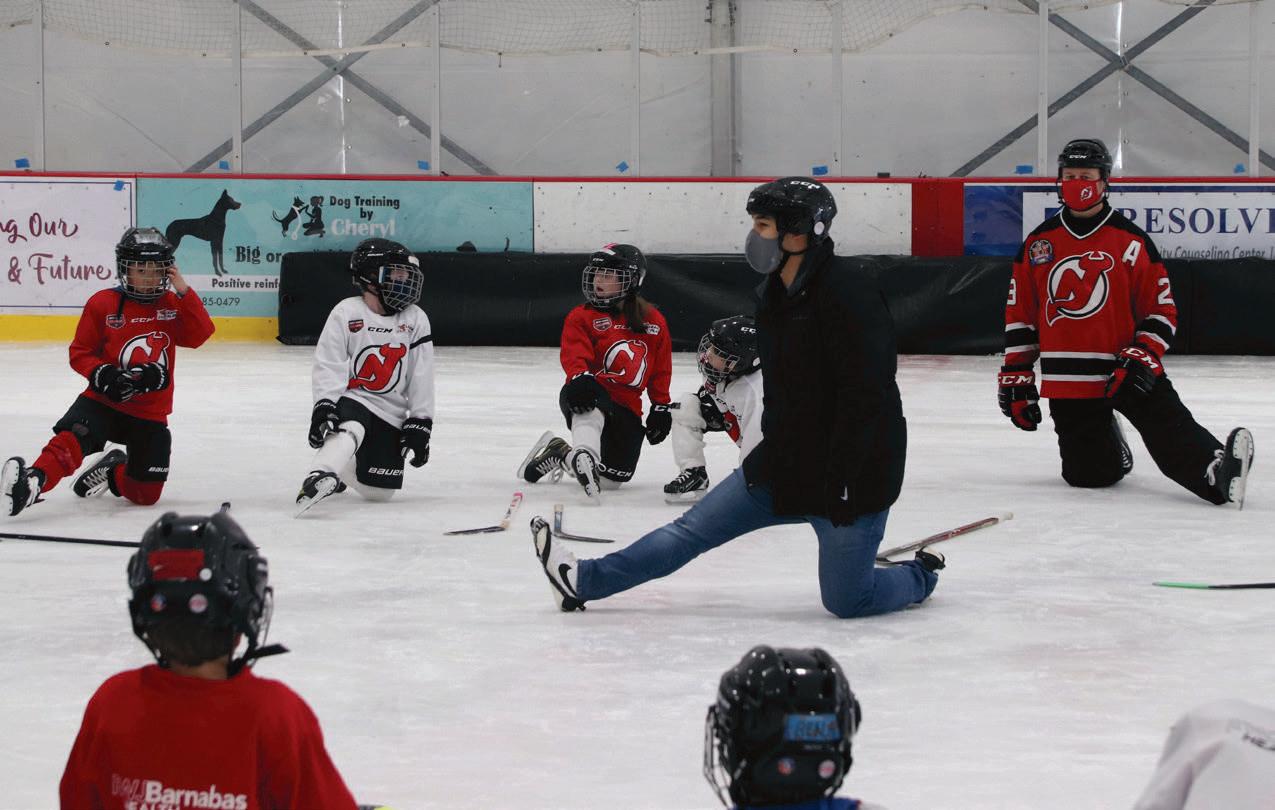

between the organizations. The home jersey branding will be fully integrated throughout RWJBH and Devils activations on and off the ice and throughout the community.
“We are beyond excited to extend our long-standing partnership with the largest academic healthcare system in New Jersey,” says Jake Reynolds, President, New Jersey Devils and Prudential Center.
The agreement also expands RWJBH’s current Devils initiatives, which include:
• Hosting the annual Running with the Devils 5K Run & Walk, offering live and virtual options to promote healthy, active lifestyles
• Supporting youth hockey programs such as Learn to Play and high school hockey
• Continuing to provide support from Devils players, alumni and mascot for community-based programs, including annual systemwide hospital visits designed to lift the spirits of patients and staff during the holiday season
• Hosting annual blood drives, community screenings and important cause nights, along with immersive patient experiences such as the Rock Star program. This VIP gameday experience honors patients and their RWJBH healthcare teams, incorporating elements such as meeting players and in-game recognition
• Continuing to be the presenting partner of the Devils’ annual Hockey
Fights Cancer Night, an opportunity to raise awareness and funds for cancer research and care while honoring a patient/cancer survivor and their healthcare team. To date, funds from this initiative have supported the renovation/enhancement of infusion centers at several hospitals, a new waiting room at The Valerie Fund at Newark Beth Israel Medical Center and the purchase of several vehicles to provide patient and clinical team transportation.
Moreover, the RWJBH Hockey House— located at Prudential Center and the home for youth teams, club teams, high school teams and special events throughout the year—will continue to serve as a primary venue to engage with youth and support community-based health initiatives.
In striving to give Devils players and staff access to the best available supportive athlete care, a dedicated RWJBH physician will serve as the club’s associate provider, working with the club’s athlete care team. The RWJBH network will continue to provide medical testing services including team physicals, imaging, lab work and injury prevention strategies and treatment
to best support players’ fitness while keeping them on the ice and performing at the highest level.
Devils defenseman Dougie Hamilton will also partner with RWJBH to launch Dougie’s Buddies, a community program in which, twice a month throughout the season, Hamilton will host a guest and their family at a Devils home game. The experience includes tickets to the game, food and beverage, Devils merchandise and a postgame meet-and-greet with Hamilton.
“Connecting with our youth is a passion of mine, and it is an honor to partner with RWJBarnabas Health to launch this community program and create a meaningful experience for children and their families,” Hamilton says.
“For 30 years, RWJBarnabas Health and the Devils have been synonymous with the state of New Jersey—longterm partners who care about their communities and giving back together,” says Devils Executive Vice President of Hockey Operations and former Hall of Fame goaltender Martin Brodeur. “There is no better connection to have than with an organization that shares our values, and it’s great for this generation of Devils stars to showcase that on their jerseys.”
To learn more about RWJBarnabas Health programs and services or to find a doctor, visit www.rwjbh.org
RWJBarnabas Health and the Devils collaborate on a variety of initiatives that advance community health goals, including (left) the Learn to Play youth program and (right) blood drives to replenish vital units of lifesaving blood.
Nursing is said to be the backbone of healthcare. But in both healthcare and humans, the back takes on high stress. It needs to be strong to keep the whole body—or healthcare system—fully functional, resilient and effective. In healthcare, strong nursing ensures good health not just for hospitals and systems but ultimately for patients.
That’s the thinking behind a key framework called RWJBarnabas Health (RWJBH)—The Institute for Nursing Excellence. “Our goal is to build and sustain a nursing workforce that’s representative of the communities we serve through new knowledge and innovations that help improve outcomes for patients and families, reduce costs and provide greater access to care,” says
Nurses who are not only skilled but also engaged and satisfied are more likely to keep practicing, Holecek says. “When you have consistency from highly knowledgeable and competent nurses who have developed as experts in their fields, you have exceptionally good care.”
Nancy Holecek, MAS, MHA, BSN, RN, FNAP, Executive Vice President and Chief Nursing Officer, RWJBH.At The Institute’s core is The Center for Professional Development, Innovation and Research (CPDIR), which is dedicated to ensuring that RWJBH healthcare team members have the resources to excel. Nursing education plays a crucial role in shaping the knowledge, skills and competencies of nurses, which in turn can have a significant impact on patient outcomes. “We believe that nursing excellence is achieved through professional development, upskilling and reskilling,” says Mary Beth Russell, PhD, MA, RN, NPDA-BC, NEA-BC, FNAP, CPHQ, Senior Vice President, The Center for Professional Development, Innovation, Research and The Institute for Nursing Excellence, RWJBH.
The Institute and its mission are supported by The CPDIR, which offers a range of educational programs and initiatives designed to support the professional development of nurses and interprofessional teams at all levels. Through continuous learning and innovation, The Institute is advancing nursing excellence at RWJBH through several key goals:
Professional development teams work at the system level and at each RWJBH hospital to coordinate and conduct consistent orientation programs for nurses and assistive personnel. Teams also provide standardized specialty training for nurses who work in operating rooms, emergency departments, and perinatal and neonatal units, to name a few. Simulation-based education programs enable nurses to rehearse best practices with healthcare professionals so they have firsthand familiarity with clinical methods and situations before caring for real patients.
For recent nursing school graduates, a residency program provides a comprehensive onboarding process throughout the RWJBH system. The
residency program not only facilitates the transition from academic to clinical settings in a collaborative and supportive way but also promotes ongoing professional development. “We’re bridging the gap between the classroom and real-life experience,” Russell says.
RWJBH now conducts regional orientation for nurses in the system’s northern and southern areas to reduce redundancy and promote consistency. “We’re communicating information to new hires in the same way regardless of where they work,” Russell says, adding that this not only encourages reliable practices but also engages nurses. “They enjoy being in the same room with people from all over the system. Not being siloed at their site gives them a macro perspective that’s not just systemwide but also nationwide and interprofessional.”
Nursing is a dynamic profession that constantly evolves with new innovations and research. Keeping up requires updating policies and procedures through reviews of the evidence-based literature in nursing. But it also requires disseminating new information and giving nurses training opportunities to apply it. “We’re actively assessing what we do, applying new information, evaluating and teaching nurses to implement new best practices,” Russell says.
Working with academic partners such as Rutgers School of Nursing and RWJBH’s Trinitas School of Nursing, a designated National League for Nursing Center of Excellence in Nursing Education, The Institute doesn’t just provide graduates with clinical placements but also offers students programs such as externships. Dedicated education units allow a student to work directly with an
RWJBH preceptor (a more experienced clinician) to gain a better sense of what it’s like to work in a given setting. Hired graduates may have an opportunity to begin orientation on a dedicated orientation unit.
Nurses work closely with other professionals. Learning more about what other team members do and enhancing collaboration helps nurses do their own jobs better. “Partnering means having interprofessional discussions not only with physicians but also with people such as physician assistants, advanced practice nurses, dietary professionals and respiratory therapists,” Russell explains. “It also means having discussions with people in nonmedical fields. For example, collaborating with people in professions such as environmental services or engineering could help reduce the risks of patients falling when they get out of bed.”
These measures and others establish RWJBH as a leader in nursing professional development and advancement, Russell says. But helping nurses stay at the top of their game doesn’t just benefit patients and the RWJBH system; it helps nurses themselves.
“When we’re giving nurses opportunities to gain knowledge, build skills, add credentials, align practices, and share evidence and innovations, it lets them know that RWJBH supports them,” she says.
That’s been especially important since the COVID-19 pandemic. “Nursing is different than it was years ago, with high levels of acuity and intensity along with mitigating factors like behavioral health, comorbidities and issues such as long COVID,” she says. “Knowing that they have the resources they’ll need gives nurses a secure feeling. That promotes engagement, which ties in to better patient outcomes. We’re taking nursing to the next level.”
TWO BROTHERS STRENGTHEN THEIR CONNECTION THROUGH THE TRANSPLANT OF A DONATED KIDNEY.

As a firefighter in El Mirage, Arizona, Corey Lydell risks his life to help others every day. So, when his half brother Brian desperately needed a kidney transplant in New
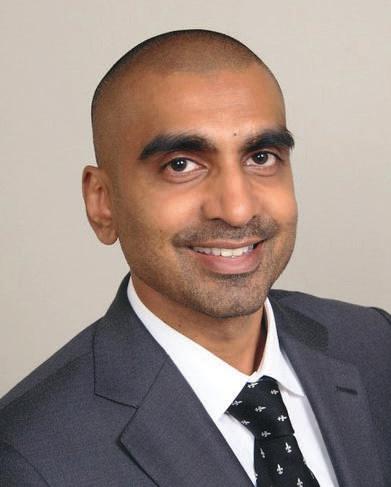

Jersey, Corey didn’t hesitate to act.
“I asked him repeatedly, ‘Are you sure you want to do this?’” Brian recalls. “He said, ‘Absolutely. As a firefighter I put my life on the line for total strangers every day. It would be silly not to do it for my brother.’”
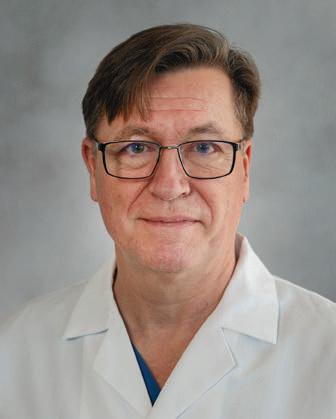
They now share an unbreakable bond through what is often called the ultimate gift.
On November7, 2023, surgeons
with the Robert Wood Johnson University Hospital (RWJUH) Kidney and Pancreas Transplant Program successfully transplanted into Brian a kidney donated by Corey. The surgery was performed by Ronald Pelletier, MD, Surgical Director of Kidney and Pancreas Transplantation for RWJUH, and Advaith Bongu, MD, a transplant surgeon with RWJUH’s program.
The half brothers learned that they could be a match for a living-donor transplant when Brian shared his story with his father and stepmother, who live in Arizona along with Corey.
ADVAITH BONGU, MD SANDESH JAIN, MD
“When I told them that I needed a kidney and that I was an O-negative blood type, they said, ‘We have plenty of O-negative over here,’” Brian says. “I didn’t want to ask them or anyone for a kidney, but the next day, Corey called and said that he wanted to donate.”
The transplant marked the end of a long, difficult journey for Brian. For most of his adult life, he suffered from the effects of ankylosing spondylitis, an inflammatory arthritis that severely
affected large joints throughout his body and required multiple joint replacement surgeries.
Brian’s path to needing a new kidney began when a tumor developed around his fibula. Surgeons removed the tumor, but follow-up scans revealed abnormalities that eventually led to the discovery of a mass on one of Brian’s kidneys. Doctors at Rutgers Cancer Institute of New Jersey, the state’s only NCI-Designated Comprehensive Cancer Center, identified multiple cancerous tumors in one kidney.
One tumor was close to the renal artery and considered unstable, so surgeons were unable to remove it, and the kidney could not be saved. “After surgery, I was fine, but the problem was that my other kidney wasn’t quite waking up,” Brian says.
Brian remained under the care of Sandesh Jain, MD, a nephrologist affiliated with RWJUH in New Brunswick and RWJUH Somerset, who monitored his kidney function closely. The kidney functioned well enough for Brian to avoid dialysis for almost a year. But one day, everything changed.
“I was driving to work and felt like I wanted to die; I felt so ill instantly,” he recalls. “I shook it off in 10 minutes, but I had never felt that way before.”
Brian’s lone functioning kidney was beginning to fail. “It was a very slow decline, but I would have bouts of fogginess and just not feeling right,” Brian says. “Dr. Jain became concerned that I was the type of person who would just keep fighting through this, and then one day, my body would just stop. He recommended that I go on dialysis.”
Once on dialysis, Brian also began the evaluation process for a kidney transplant. The RWJUH team felt he stood a greater chance of finding a match faster if he considered a livingdonor kidney.
People who have kidney failure are encouraged to seek living donors for a kidney transplant because:
• Recipients bypass the wait for a deceased donor’s kidney and receive a kidney faster.
• Dialysis takes a toll on the heart. Receiving a kidney from a living donor can reduce the risk of cardiac complications.
• A living donor’s kidney is less likely to be rejected by the recipient’s immune system than a kidney from a deceased donor.
• Recipients of kidneys from living donors have notably higher success rates and shorter hospital stays, and require less immunosuppression than those who receive kidneys from deceased donors.
• Kidney donation surgery is generally done laparoscopically.
Before donating, Corey talked to a friend who had donated a kidney to his mother and learned about the benefits of living donation.
“It’s family, and I wanted to see Brian have a normal, healthy life so he could be there for his wife and children,” Corey says. “Seeing him get healthy and back to normal— being able to enjoy family time like Thanksgiving dinner again—makes it all worth it.”
It’s difficult for Brian to put into words what Corey’s selfless act means to him.
“I tell him he’s Superman and he can do no wrong,” Brian says. “It’s such a great gesture that it’s hard to put into words and say something that would do it justice. Corey is very low-key. To him, it’s probably enough that he had the satisfaction of seeing me get better. Now, I have to do everything I can to keep this kidney healthy as long as possible. I’m very aware of the sacrifice he made, and I want to make sure that it is honored.”
To learn more about transplants at RWJBarnabas Health, visit www.rwjbh.org/transplant
No one plans heart disease. But everyone have a plan for
Choose the network that handles all aspects of heart health.
From state-of-the-art technology to the most specialized team in New Jersey, our network offers the most complete heart and vascular care. Whether you have hypertension, heart disease or a child a heart issue, our team of nurses, cardiologists heart surgeons deliver comprehensive, compassionate care. Our highly coordinated approach to patient ensures that you can focus on improved health wellness – and get your heart off your mind. Make a plan at rwjbh.org/heart
